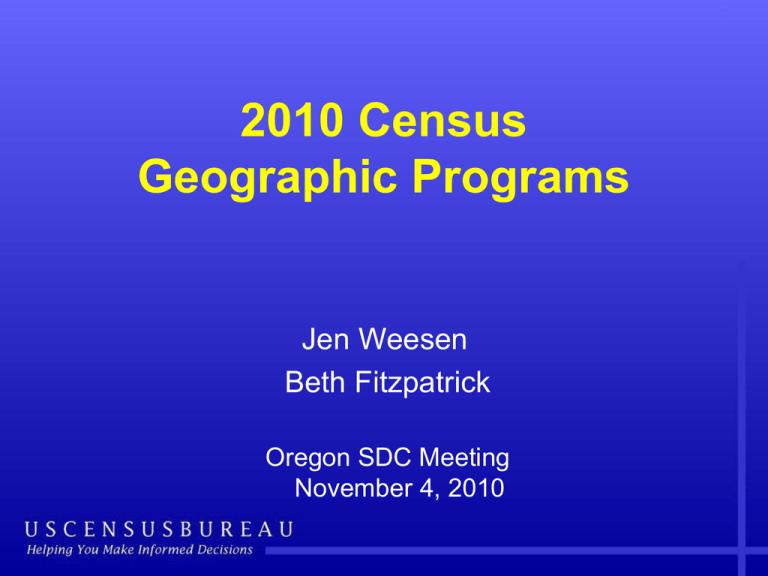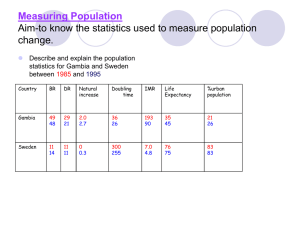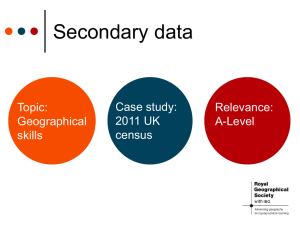Geographic Topics - Portland State University
advertisement

2010 Census Geographic Programs Jen Weesen Beth Fitzpatrick Oregon SDC Meeting November 4, 2010 Participant Geographic Programs • BAS - Boundary and Annexation Survey • AIA BAS - American Indian Area Boundary and Annexation Survey • PSAP - Participant Statistical Areas Program • TSAP - Tribal Statistical Areas Program • Redistricting Data Program Post-2010 Geographic Areas • • • • ZCTAs - ZIP Code Tabulation Areas Urban Areas – Urban/Rural TAZs - Traffic Analysis Zones PUMAs - Public Use Microdata Areas Boundary and Annexation Survey (BAS) • Collect boundary change information for legal areas • Survey universe includes all legal entities • Enables data reporting for: – – – – – 2010 Census American Community Survey Economic Census Population Estimates Other Census Bureau surveys • American Indian Area (AIA) BAS – Update reservation and trust land inventory BAS Annual Schedule • Materials Mailout – Winter • Submission Deadline – March 1st • Response Methods – Paper – MAF/TIGER Partnership Software (MTPS) – Digital BAS (ArcGIS Shapefiles) • AIA BAS Submission Deadline – March 1st Participant Statistical Areas Program (PSAP) • Enables coordinating agencies to identify and propose boundary changes for census tracts, block groups, census designated places, and census county divisions in accordance with Census Bureau criteria – Counties, regional planning agencies, council of governments • Response Method – MTPS Statistical Area Criteria Differences from 2000 2000 Minimum Optimum 2010 Maximum CT 1,500 4,000 8,000 BG 600 1,500 3,000 Minimum Optimum Maximum 1,200 HU 480 600 HU 240 CDP - Cannot have zero population or housing units - Cannot be coextensive with an incorporated place - Must represent a single, distinct community 4,000 8,000 1,600 3,200 none 3,000 none 1,200 PSAP Schedule • Materials Mailout – Fall 2008 • Submission Deadline – Spring 2009 • Verification Phase – Spring 2010 Oregon PSAP Participation • RCC – 19 Counties • COG/MPO – 16 Counties • County – One (Klamath) Tribal Statistical Areas Program (TSAP) • Enables tribes to define statistical American Indian Areas – Used to collect, tabulate, and present data • Separate geographic layer – Tribal tracts and block groups may cross county and state boundaries – Tribal tracts and block groups can be discontiguous – Must follow same population and housing unit thresholds as standard tracts and block groups Tribal Statistical Areas Program (TSAP) • Tribe-Delineated CDPs – Tribes can submit CDPs within reservation/trust land boundaries – Tribes can work with PSAP participants to delineate off-reservation CDPs • Response Methods – Paper Maps – ESRI ArcGIS TSAP Extension Tribal Statistical Area Criteria TSAP Schedule • Invitation Mailout – Fall 2008 • Materials Mailout – Winter 2009 • Submission Deadline – Summer 2009 • Verification Phase – Spring 2010 • TCTs and TBGs updated yearly as reservation and trust land boundaries change Oregon TSAP Participation • RCC – – – – – – – Burns Paiute Colony Celilo Village Coquille Reservation Cow Creek Reservation Klamath Reservation Siletz Reservation Umatilla Reservation • Tribes – Grande Ronde Community – Warm Springs Reservation – Coos, Lower Umpqua, and Siuslaw Reservation Redistricting Data Program • Enacted by Congress in December 1975, Public Law 94-171 requires the Census Bureau to provide states with the opportunity to specify geographic areas for which they wish to receive census population tabulations • Requires the Census Bureau to tabulate decennial census population data, according to the geographies submitted in the state plan, no later than April 1, 2011 Phase 1 – State Legislative District Project (SLDP) (2004-2006) • Collection of State Legislative District (SLD) boundaries (House and Senate) • 100% participation • Completed in January 2007 Phase 2 – Voting Tabulation District (VTD) Block Boundary Suggestion Project (BBSP) (2007-2010) • This phase combined the option to – submit voting district boundaries for 2010 Census tabulation block boundaries – suggest 2010 Census tabulation block boundaries • Participation in both components or just one • Verification phase included for all components (VTD/SLD/CD) Phase 3 – Delivery of the Decennial Census 2010 Redistricting Data (2010-2011) In accordance with 13 U.S.C. 141(c) the Governor and legislative leaders of both the majority and minority parties will receive population counts for standard geographies down to the census tabulation block no later than April 1, 2011 Data Delivery • Delivery of population counts to the President by December 31, 2010 • TIGER/Line Shapefiles to states in late November 2010 through January 2011 • P.L. data to states February through March 2011 – Must be delivered by April 1, 2011 Phase 4 – Collection of Post-Census 2010 Redistricting Plans (2012-2013) • The Census Bureau will collect from each state newly drawn congressional and legislative district plans • The Census Bureau will re-tabulate 2010 census data for these newly drawn boundaries • The American Community Survey (ACS) will also tabulate ACS data for these newly drawn boundaries Phase 5 – Evaluation and Recommendations (2012-2014) • Evaluation of Census 2010 Redistricting Data Program • Recommendations for the 2020 Census • “View from the States” – Final phase will result in the 4th edition with recommendations for the 2020 Census Post-2010 Census Geographic Areas Urban Areas: Census 2000 Overview • • • • ZCTAs - ZIP Code Tabulation Areas Urban Areas – Urban/Rural TAZs - Traffic Analysis Zones PUMAs - Public Use Microdata Areas ZIP Code Tabulation Area Delineation • 5-digit ZCTAs only for Census 2010 – No 3-digit ZCTAs • 2010 census blocks will form the “building blocks” for ZCTAs • ZCTAs will be defined only for areas with residential ZIP Codes – Will not cover the entirety of the nation • ZCTAs will more closely approximate ZIP Codes Initial ZCTA Line Insertion Software An example of block and MSP address configuration where a block split should occur The most frequently occurring ZIP Code in this block is associated with only 60% of the addresses. Initial ZCTA Line Insertion Software Example of adding a ZCTA split line to a block ZCTAs Delineation Schedule • Spring 2010: Added non-visible edges to MAF/TIGER Database • November 2010 - March 2011: ZCTA delineation • April 2011: ZCTA TIGER/Line Shapefiles Urban/ Rural (Urban Areas) • Two types of urban areas: – Urbanized areas of 50,000 or more people – Urban clusters of at least 2,500 and less than 50,000 people • Rural areas – Territory outside urban areas • Census Bureau has classified Urban since 1906 • Urbanized Areas defined since 1950 Census • Urban Clusters defined first for Census 2000 Differences Between Census 2000 Urban Area Criteria and Proposed Urban Area Criteria for the 2010 Census Criterion Initial Analysis Unit Maximum Jump Distance Airports Central Place Minimum Population Splitting Census 2000 Final Proposed 2010 Census Block Group Census Tract 2.5 miles 1.5 miles & no hops after jump 10,000 enplanements 2,500 enplanements Defined Not defined 2,500 2,500 & 1,500 outside institutional GQs 50,000+ 1,000,000+ Urban Areas: Schedule • November 22, 2010: Public comment period ends for proposed criteria published in Federal Register – http://www.census.gov/geo/www/ua/urbanruralclass.html • First quarter of 2011: Final criteria published in Federal Register • March-December 2011: Delineation • Spring 2012: Federal Register notice listing Urban Areas • Spring 2012: Urban/Rural TIGER/Line Shapefiles Traffic Analysis Zones: Background • Sponsors – American Association of State Highway and Transportation Officials (AASHTO) – Federal Highway Administration (FHWA) • Census Transportation Planning Products (CTPP) – Largest special tabulation done by the Census Bureau • Primary participants – Metropolitan Planning Organizations (MPOs) – State Departments of Transportation (SDOTs) Traffic Analysis Zones Two types of areas: • Traffic Analysis Zones (TAZs) – Defined based on 2010 census blocks • Traffic Analysis Districts (TADs) – New for 2010 – Aggregations of TAZs Traffic Analysis Zones: Schedule • March/early April 2011: Mail out of materials to MPOs and State DOTs – Participants have 3 months to delineate TAZs • June 2011: Return deadline for submissions • October 2012: TIGER/Line Shapefiles include 2010 TAZs PUMA Types • Standard PUMAs (one level) • Place-of-work (POW) PUMAs and migration (MIG) PUMAs are proposed to be county based, consisting of: – – a single PUMA for county-based PUMAs a combination of adjacent tract based-PUMAs, so that together the PUMAs compose one or more complete counties Boundary Symbology PUMA 1 PUMA 2 County Tract-based PUMA POW PUMA & MIG PUMA County A County B PUMA 3 POW PUMA I and MIG PUMA I Population Threshold for PUMAs • Each PUMA must have a minimum 2010 Census population of 100,000 • Minimum population must be met at the time of delineation and maintained throughout the decade • Number of PUMAs should be maximized – PUMAs should not contain more than 200,000 people PUMA Guidelines • Federal American Indian reservation/off-reservation trust land (AIR/ORTL) relationship wherever possible • Wherever possible, each PUMA should comprise an area that is either entirely inside or entirely outside a current Core Based Statistical Area • Use place definitions, urban/rural definitions, as well as local knowledge to inform PUMA delineation PUMA Draft Schedule • November 2010: Proposed criteria will be distributed to SDCs and a wide variety of stakeholder groups • August 2011: Materials sent to SDCs for PUMA delineation • Fall 2011: Hands on training using MTPS • January 3, 2012: Return deadline for submissions Seattle Regional Census Center Jen Weesen Beth Fitzpatrick Geographer Jennifer.Weesen@census.gov 425-908-3017 Geographer Beth.A.Fitzpatrick@census.gov 425-908-3013 Census Bureau Geography Website http://www.census.gov/geo/www/index.html







